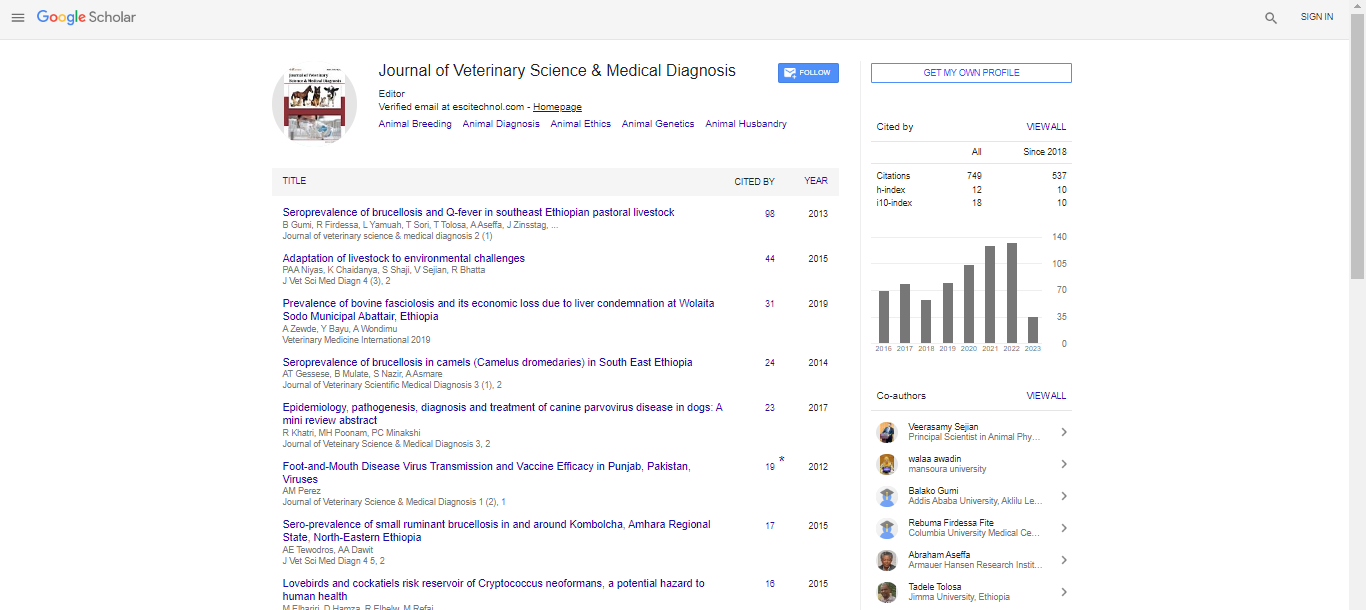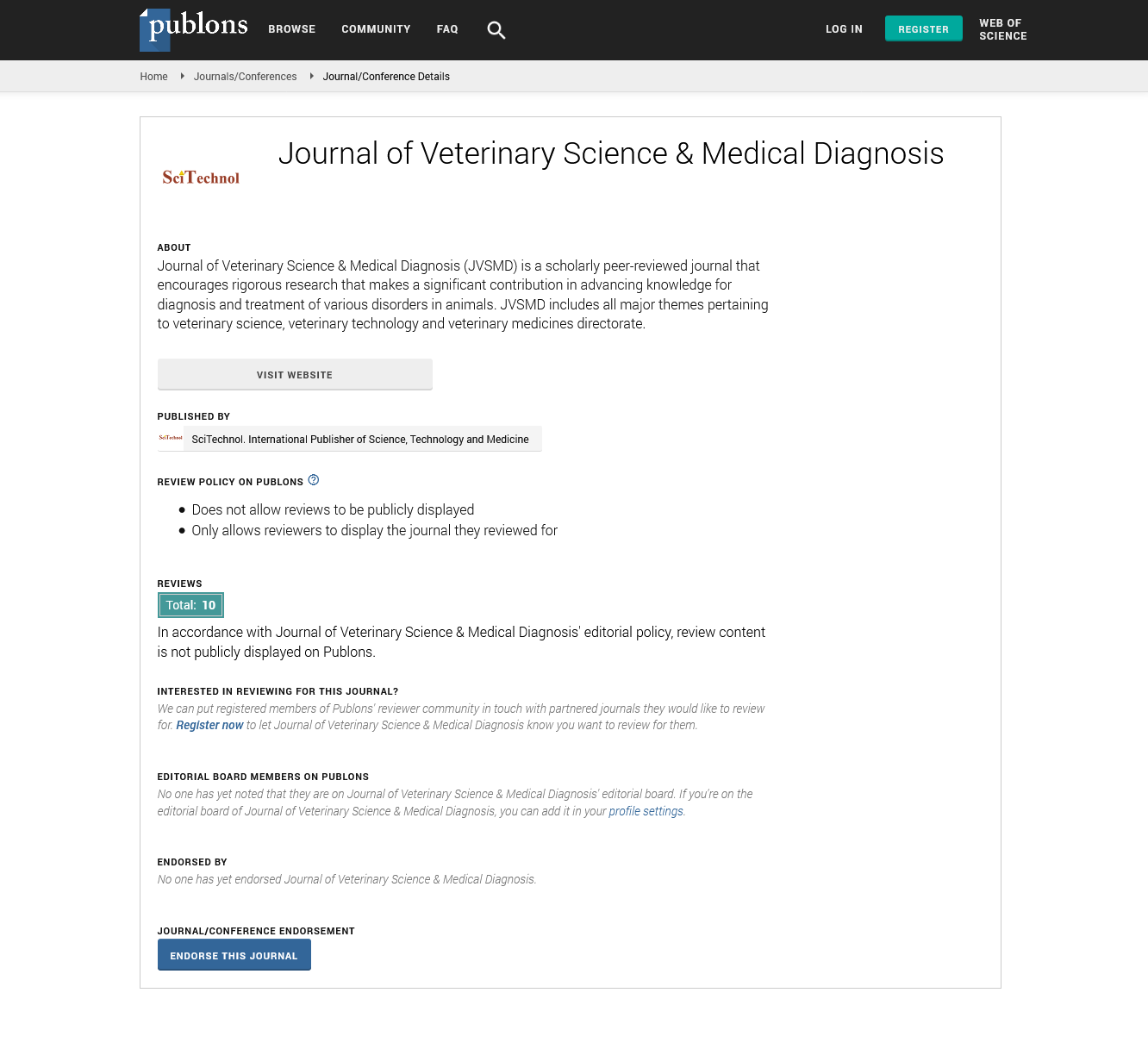Commentary, J Vet Sci Med Diagn Vol: 11 Issue: 3
Animal Nutrition Information Boost and the Demand for Organic Meat
Hilal Arslan*
Department Knowledge and Valorisation of Agricultural Products, European Union Reference Laboratory for Animal Proteins in Feeding stuffs, Gembloux, Belgium
Corresponding Author: Hilal Arslan
Department Knowledge and Valorisation of Agricultural Products, European Union Reference Laboratory for Animal Proteins in Feeding stuffs, Gembloux, Belgium
E-mail: arslan.hi@gmail.com
Received date: 25 February, 2022, Manuscript No. JVSMD-22-62341;
Editor assigned date: 28 February, 2022, Pre QC No. JVSMD-22-62341 (PQ);
Reviewed date: 11 March, 2022, QC No JVSMD-22-62341;
Revised date: 21 March, 2022, Manuscript No. JVSMD-22-62341 (R);
Published date: 28 March, 2022, DOI: 10.4172/2325-9590.11.3.011
Citation::Arslan H (2022) Animal Nutrition Information Boost and the Demand for Organic Meat. J Vet Sci Med Diagn 11:3.
Keywords: Animal Nutrition
Description
Nutrition is outlined because the method of providing and getting the food necessary for the health and growth of animals. Food nutrients square measure used because the main energy supply by associate degree animal via numerous processes, as well as digestion and absorption within the digestive tube, blood transport, and metabolism within the cells. Regulation of animal nutrition is related to the functions of varied tissues and organs in animals. New and evolving ideas in animal nutrition and metabolism gift new analysis challenges that need knowledge base collaboration, a rethinking of ancient disciplinary boundaries, and adaptation of latest analysis methodology. During this article, I’ll concentrate on 3 of that challenges–comparative nutrition, the connection between medical specialty and organic process illness, and nutrigenomics describing the event of recent advances and promising areas for future analysis, as well as new treatments for metabolic illness.
Bioavailability Assessment of Food Nutrients
Studies on comparative animal nutrition begin with analysis of the processes of energy metabolism. Energy metabolism and imbalances in metabolic processes will induce numerous diseases in animals. Energy metabolism is that the method of adenosine triphosphate production. In growth cells, energy metabolism processes, as well as the monosaccharide phosphate pathway and therefore the malate aspartate shuttle, square measure accelerated remarkably, whereas, adenosine triphosphate production through metabolic process decreases greatly within the tissues of diabetic animals. Observation adenosine triphosphate production in tissues is efficient thanks to perceive the health conditions of animals. Further, the connection between energy metabolism, medical specialty, and medical specialty is vital to understanding metabolic disorders in animals.
Great progress was created within the organic process sciences throughout the twentieth century. By 1948, all of the essential vitamins had been discovered, and their synthesis was accomplished. The last of the amino acids found in food proteins (i.e., threonine) was isolated in 1935. Outlined functions for dietary essential mineral parts and extremist trace parts conjointly were discovered. Specific dietary necessities for essential nutrients were after listed for animals by national analysis council and for humans by Food and Nutrition Board committees of the National Academy of Sciences. Varied philanthropist Prizes were awarded for this body of labor, significantly for the invention of vitamins and their role in nutrition and illness.
World-wide, deficiencies of anti-ophthalmic factor, iron, and high-quality super molecule square measure typically thought-about the foremost serious issues in human nutrition. Distinguished queries these days square measure whether or not a job exists for nutrients on the far side their role in preventing specific deficiencies. Thus, wide attempt is being exhausted into the role of sure carotenoids in preventing devolution and cataracts, specific tocopherol isomers as antioxidants, numerous hydroxylase fat-soluble vitamin product for promotion of gut absorption of Ca and P likewise as for treatment of pathology and skin disorder, pharmacological Se and conjugated polyunsaturated fatty acid for cancer bar, and chosen amino acids at pharmacological dose levels for a bunch of clinical conditions. Additionally, avoirdupois and adult became serious issues in developed countries like the U.S. Terms like glycemic index, soluble vs. insoluble and possible vs. non-fermentable fiber, and undigested starch have entered our vocabulary.
Bioavailability assessment of food nutrients has advanced to the purpose wherever we have a tendency to currently have affordable estimates of edibleness and absorbability of most nutrients during a food matrix. Large variations exist in bioavailability each at intervals and among nutrient teams. at intervals dietary essential mineral parts, for instance, some eaten parts in inorganic kind square measure virtually fully absorbed (e.g., K, Na, Cl, I, F), some have 70%–90% absorption potency (P, Se, B, As), some have 30–40% (Ca, Mg, Cu), some have 15%–20% (Fe, Zn, Ni), some have 5% (Mn, V), and a few have and some have <1% (Cr). Ratios of one element to another in a meal also are known to substantially affect absorption efficiency; this is illustrated by excess dietary Zn reducing Cu and Fe absorption and excess dietary P reducing Mn absorption. Moreover, certain food ingredients in the vegetable category can bind mineral elements and reduce their bioavailability: Phytic acid (inositol hex phosphate) binds not only P, but also Ca, K, Zn, and Fe, and oxalates in foods like spinach can strongly bind Ca and Fe.
With vitamins, whether existing in foods as free vitamins or coenzymes, cooking, baking, and other food processing procedures can markedly reduce the bioavailability of vitamins like thiamine and flacon that contain a free amino group. Heat processing also reduces the bioavailability of certain protein-bound amino acids that contain a free amino group (lysine) via the same mechanism; this occurs prominently when cookies, cakes, or bread is baked and when bread is toasted.
Molecular Genetic
Molecular genetic approaches are being used today to engineer food crops to have increased concentrations of specific nutrients. β-carotene is the direct vitamin A precursor in plant-derived food products. The entire biosynthetic pathway of β-carotene biosynthesis in plants is now known, and its first application was in the development of transgenic rice (i.e., golden rice) that contained a substantial increase in β-carotene. Biosynthetic pathways for α-tocopherol (vitamin E) and folacin have been established as well. Plant geneticists have also found ways to engineer food crops to have increased levels of lysine and iron, and decreased levels of phytic acid.
Everyone seems to be interested in their own nutrition and health, and this has led to a plethora of so-called “Nutritional supplements” being made available (without prescription) to the general public. Those of us who consider ourselves nutritional professionals find this alarming. Indeed, many of these supplements have no demonstrated efficacy or safety data to justify their use. Also, several essential nutrients (no nutrients) available for sale to the general public are toxic at higher dose levels, Se, V, cysteine, and vitamin A.
 Spanish
Spanish  Chinese
Chinese  Russian
Russian  German
German  French
French  Japanese
Japanese  Portuguese
Portuguese  Hindi
Hindi 
